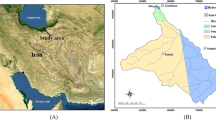Abstract
An artificial neural network (ANN) model was developed for simulating water levels at the Sultan Marshes in Turkey. Sultan Marshes is a closed basin wetland located in the semi-arid Central Anatolia region of Turkey. It is one of the thirteen Ramsar sites of Turkey and a national park. Water levels at the Sultan Marshes showed strong fluctuations in recent decades due to the changes in climatic and hydrologic conditions. In this study, monthly average water levels were simulated using a multi-layer perceptron type ANN model. The model inputs consisted of climatic data (precipitation, air temperature, evapotranspiration) and hydrologic data (ground water levels, spring flow rates, and previous month water levels) available from 1993 to 2002. 70 % of the data were used for model training and remaining 30 % were used for model testing. Model training was accomplished by using a scaled conjugate gradient backpropagation algorithm. The performance of the model was evaluated by calculating the root mean square error (RMSE) and the coefficient of determination (R 2) between observed and simulated water levels. The sensitivity of the model to input parameters was determined by evaluating the model performance when a single input variable was excluded. It was found that the ANN model can successfully be used for simulating water levels at the Sultan Marshes. The model developed using all input variables provided the best results with two neurons in the hidden layer. The RMSE and R 2 of the simulated water levels were 4.0 cm and 96 %, respectively. The sensitivity analysis showed that the model was most sensitive to previous month water levels and ground water levels.




Similar content being viewed by others
References
Ali A (2009) Nonlinear multivariate rainfall–stage model for large wetland systems. J Hydrol 374:338–350
Allen RG, Pereira LS, Raes D, Smith M (1998) Crop evapotranspiration—guidelines for computing crop water requirements. FAO—Food and Agriculture Organization of the United Nations, Rome
Altunkaynak A (2007) Forecasting surface water level fluctuations of Lake Van by artificial neural networks. Water Resour Manag 21:399–488
ASCE (2000a) Artificial Neural Networks in Hydrology. I: Preliminary Concepts. J Hydrol Eng 5 (2):115–123
ASCE (2000b) Artificial Neural Networks in Hydrology. II: Hydrologic Applications. J Hydrol Eng 5 (2):124–137
Chang F-J, Chen Y-C (2003) Estuary water-stage forecasting by using radial basis function neural network. J Hydrol 270:158–166
Dadaser-Celik F, Stefan HG, Brezonik PL (2006) Dynamic hydrologic model of the Örtülüakar Marsh in Turkey. Wetlands 26(4):1089–1102
Dadaser-Celik F, Brezonik PL, Stefan HG (2007) Hydrologic sustainability of the Sultan Marshes in Turkey. Water Int 32(5):856–876
Dadaser-Celik F, Bauer ME, Brezonik PL, Stefan HG (2008) Changes in the Sultan Marshes ecosystem (Turkey) in satellite images 1980–2003. Wetlands 28(3):852–865
Daliakopoulos IN, Coulibaly P, Tsanis IK (2005) Groundwater level forecasting using artificial neural networks. J Hydrol 309(1–4):229–240
Demirel MC, Venancio A, Kahya E (2009) Flow forecast by SWAT model and ANN in Pracana basin, Portugal. Adv Eng Softw 40(7):467–473
DSI (1995) Develi-Yesilhisar Ovasi Revize Hidrojeolojik Etudu (Revised Hydrogeologic Study of Develi-Yesilhisar Basin). Devlet Su Isleri (State Hydraulic Works), Ankara, Turkey
Feng S, Kang S, Huo Z, Chen S, Mao X (2008) Neural networks to simulate regional ground water levels affected by human activities. Ground Water 46(1):80–90
Gilman K (1994) Hydrology and wetland conservation. John Wiley and Sons, New York
Haykin S (1994) Neural networks: a comprehensive foundation. MacMillan, New York
Magnin G, Yarar M (1997) Important bird areas in Turkey. The Society for the Protection of Nature, Istanbul
McCulloch WS, Pitts WH (1943) A logical calculus of the ideas immanent in nervous activity. Bull Math Biol 5:115–133
Mitsch WJ, Gosselink JG (1993) Wetlands, 2nd edn. Van Nostrand Reinhold, New York
Møller MF (1993) A scaled conjugate gradient algorithm for fast supervised learning. Neural Netw 6(4):525–533
Pasaoglu S (1994) DSI Develi Havzasi Ekoloji Koruma Projesi (DSI Develi Basin Ecology Conservation Project). In: Kayseri Sultan Sazligi - Erciyes Cevre Sorunlari Sempozyumu (Kayseri Sultan Marshes—Mount Erciyes Environmental Problems Symposium). Kayseri Valiligi(Kayseri Governer’s Office), Kayseri, Turkey, pp 86–122
Rumelhart DE, Hinton GE, Williams RJI, editors, pages. The (1986) Learning internal representations by error propagation. In: Rumelhart DE, McClelland JL, Group tPR (eds) Paralled Distributed Processing. Explorations in the Microstructure of Cognition, vol Volume 1: Foundations. MIT Press, Cambridge, MA, pp 318–362
Singh A, Imtiyaz M, Isaac RK, Denis DM (2012) Comparison of soil and water assessment tool (SWAT) and multilayer perceptron (MLP) artificial neural network for predicting sediment yield in the Nagwa agricultural watershed in Jharkhand, India. Agric Water Manag 104:113–120
Sutcliffe JV, Parks YP (1989) Comparative water balances of selected African Wetlands. Hydrol Sci J 34(1):49–62
Thompson JR, Hollis GE (1995) Hydrological modelling and the sustainable development of the Hadejia-Nguru Wetlands, Nigeria. Hydrol Sci J 40(1):97–116
Trichakis IC, Nikolos IK, Karatzas GP (2009) Optimal selection of artificial neural network parameters for the prediction of a karstic aquifer’s response. Hydrol Process 23(20):2956–2969
Yarar A, Onucyıldız M, Copty NK (2009) Modelling level change in lakes using neuro-fuzzy and artificial neural networks. J Hydrol 365(3):329–334
Acknowledgments
We would like to thank State Meteorology Service and State Hydraulic Works for providing the climatic and hydrologic data. We would also like to thank Özge Güzel for her assistance with the calculation of evapotranspiration values.
Author information
Authors and Affiliations
Corresponding author
Rights and permissions
About this article
Cite this article
Dadaser-Celik, F., Cengiz, E. A neural network model for simulation of water levels at the Sultan Marshes wetland in Turkey. Wetlands Ecol Manage 21, 297–306 (2013). https://doi.org/10.1007/s11273-013-9301-y
Received:
Accepted:
Published:
Issue Date:
DOI: https://doi.org/10.1007/s11273-013-9301-y




